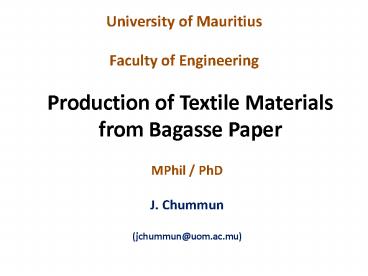Production of Textile Materials from Bagasse Paper - PowerPoint PPT Presentation
1 / 23
Title:
Production of Textile Materials from Bagasse Paper
Description:
University of Mauritius Faculty of Engineering Production of Textile Materials from Bagasse Paper MPhil / PhD J. Chummun (jchummun_at_uom.ac.mu) The aim of this project ... – PowerPoint PPT presentation
Number of Views:50
Avg rating:3.0/5.0
Title: Production of Textile Materials from Bagasse Paper
1
Production of Textile Materials from Bagasse Paper
University of Mauritius Faculty of Engineering
MPhil / PhD J. Chummun (jchummun_at_uom.ac.mu)
2
- The aim of this project is to manufacture
textiles from bagasse paper.
3
Objectives
- Investigate the parameters that influence
paper-yarns - Establish the relationship between bagasse-paper
properties such as grammage, thickness, strip
width, tensile properties and that of the
properties of the paper-yarn - Investigate into the possibility of manufacturing
paper-yarns from bagasse paper - Manufacture the appropriate structure from
bagasse paper-yarns.
4
Manufacture of textiles from bagasse paper
- The Process
- Slitting of paper into narrow strips
- Folding of strip
- Twisting the folded paper into yarn.
- Treated / Untreated yarns converted into textiles.
5
Dimensions of bagasse fibre and its derived
values showing its closeness to that of softwood
and hardwood.
6
Properties of bagasse paper and its suitability
for newsprint.
Papers manufactured from softwoods, hardwoods as
well as newsprints have been used in the
manufacture of paper-yarns. This may seem to
suggest that bagasse paper could easily be
twisted into yarn and no great difficulty should
be met during the process.
7
Twisting of dry paper-ribbon
Difficulties arise when paper ribbon are twisted
in the dry state. Moreover, depending on the
width, the ribbon tends to assume a wrapped
ribbon shape.
8
Paper Yarns
Paper strip should therefore be moistened then
folded in the condenser and finally twisted and
wound on a cone.
9
Paper Yarn
Paper Yarn with 2.7 tpi. The 44.8 gsm paper was
manufactured from unbleached softwood pulp.
10
Twist Contraction of Paper Yarns
11
Twist Contraction of Paper Yarns
To spin a yarn of a particular twist value using
a heavier paper, a longer ribbon will be
required. Thicker paper is less flexible and
therefore tends to assume a larger diameter
while being twisted and therefore a longer path
along the axis of the yarn.
12
Comparison of paper strength to yarn strength
The strength tends to increase with increasing
twist per init length until it reaches a maximum
value and then fall as the number of twists
increases.
13
Behaviour of paper yarns under load
The extensions in the yarns seem to be similar at
low loads. As the value of the load increases,
the yarns with higher twists tend to have larger
extensions.
14
Behaviour of paper yarns under load
When subjected to load along its axis, the yarn
tends to unbend, while the twist angle (or
helical angle) increases until the whole
structure is jammed.
15
Failure of paper yarns
SEM pictures to show the broken ends of
paper-yarns
16
Failure of paper yarns
It is possible that failure of a few fibres
occurs in the region of highest load and
subsequently neighbouring individual fibres will
either break or their inter-fibre bond will be
broken (Page, 1994). In this case, the breaking
would be similar to tearing.
17
Strength of Paper-yarn
- The strength of paper-yarn depends on
- strength
- grammage
- thickness of the paper it is made from
- width of the paper-ribbon used
- number of twists imparted to it.
18
Strength of Paper-yarn
- The specific strength of paper-yarns tends to be
higher at lower twist-contraction values.
19
Further Work
- The relationship between the strength of paper
strips of different widths and specific mass and
that of the yarns spun from them will be
further investigated. The manufacture of
paper-cords from heavier paper will also be
investigated.
20
Further Work
- It is envisaged to study the effects of a range
of physical processing parameters and the
incorporation of safe additives into the
bagasse paper with a view to assess key
properties such as dry and wet strength, water
penetration, air permeability, flammability,
colouration, filtration, etc.
21
Further Work
- Textile structures will be produced using the
weaving, knitting and/or braiding processes.
Their potential applications will be investigated.
22
Expected Benefits
- Could increase the income from bagasse by 500
- Opportunity for SME craft market to manufacture
green bagasse products - With some creativity, local artisanal products
may be made for the growing tourist industry - Locally available raw material that is renewable
and environmentally-friendly.
23
Acknowledgement
- University of Mauritius
- ACU
- University of Manchester (UoMan.)
- Supervisors Dr Rosunee (UoM) Prof Carr
(UoMan.) - Dr Sampson Dr IAnson Prof. Porat (UoMan.)































